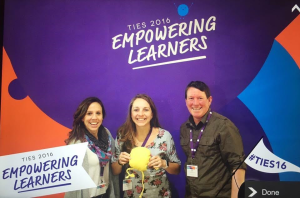The following post was submitted by CMLE scholarship recipient Katherine Vinje Stark, Instructional Technology Specialist, at Pine Meadow Elementary in Sartell.

Reflection on TIES Conference
The TIES 2016 Conference was a success. It fulfilled my expectations in that I went with the hope of more tools for our 21st century learners, including maker spaces and to feel better equipped for more job embedded professional development in our school. The keynote speaker on Monday could not have stated better, “Do not postpone joy.” Too often we are stuck in the rush of life and forget that we need to have those joyful moments if not extended periods of time to truly soak it all in and learn. If we are joyful we can retain so much more and if we make learning joyful, we are putting everyone first.
The first session I attended was to get to know and exchange experiences with other tech coaches in the Midwest. This session helped me gauge where we are at here in Sartell and I felt that we are on track. We were able to share philosophies and missions of districts and bring back feedback/ideas to ours. This was a great takeaway as it helped me get a feel for a support group in the area as well.
Another very valuable session was on flipped professional development. A school district in Wisconsin started to flip their professional development after they noticed teachers were very disengaged. They talked about PD and how teachers need: active engagement, voice, choice, collaboration, effective use of time, teacher centered meetings, meaningful application to take back with them and put into practice, modeling, teacher leadership, and a personalized agenda. I definitely feel that I can put this into practice here at Pine Meadow Elementary. I’m excited to start the conversation with my administration.
This is a very brief summary of what I soaked in. Thank you so much for supporting our library by allowing me to attend and become more in awe and wonder as to how we can get our maker space up and running (fresh maker ideas were out yesterday helping to embed STEM and language arts) as well as continue to educate our teachers, students and community.




